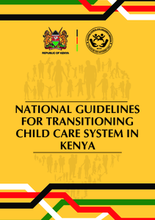The transitioning of care of children to family-based care is an important subject matter in the National Care Reforms in Kenya. In 2022, the Government of Kenya, in collaboration with stakeholders, developed the National Care Reform Strategy for Children in Kenya (2022- 2032). The Strategy seeks to guide the national steps towards Prevention and Family Strengthening, robust alternative family care, and Tracing, reintegration and transitioning from institutional care to Family and Community Based Care for all children in need of care and protection. Care reform process changes the attitudes and practice of duty bearers and other stakeholders towards family and community-based care solutions.
Tracing, reintegration and transitioning is the third pillar under the National Care Reform Strategy. This relates to the safe and sustainable transition of institutionalized children, redirection of resources and repurposing of the institutions to family and community-based care. This pillar also calls for changes in legislations, regulations and policies to provide mechanisms that encourage donors to transition funding from institutions to family and community-based care. The National Transition Guidelines therefore provides a roadmap of activities to guide the state and non-state actors in Kenya to streamline the transitioning of care systems, children and institutions in the country.
The national transitioning guidelines provide for a coordinated transitioning mechanism and approaches to implement the National Care Reform Strategy (NCRS). Transitioning of care cannot be done by a single organization or agency working alone but by multiple players with different but clearly defined roles and responsibilities. Shifting from a residential care model to family-based care requires collaboration amongst multiple stakeholders who will be impacted and engaged in the process. This includes families, children, residential care staff, government partners, local non-profit and community-based organizations, and religious institutions. A network of family strengthening partners equip families with the resources they need to care for their children, while also preventing family separation. These guidelines provide for the key steps to ensure that all levels of transition including the systems, institutions, children, and young persons are well prepared to take off for transition.
The process of preparing to transition from residential to family care shall be rooted in strong organizational focus, vision, mission and renewal of strategic plans where effective planning will ensure the safe transition of children into strong and nurturing families and engaged communities. Each transition is unique to its context and depends on the support and engagement of multiple stakeholders, including staff, donors, service providers, children and the families.
Also see:

